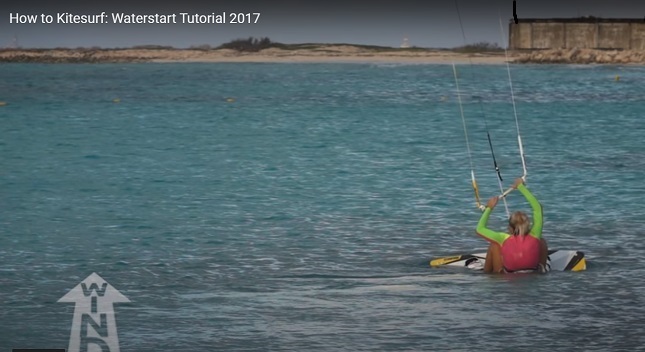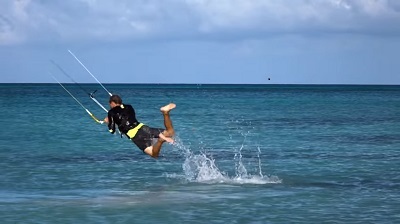This is probably the skill most beginners struggle to get right at first. But there are some basic things that will get you up on the board with style and confidence every time. So this article will remind you of how to get your kitesurfing water start nailed within a very short time.
As with all my technique articles, this is not designed to replace lessons from a qualified instructor.
If you’re anywhere near the North of the United Kingdom, why not check out Northern Kites where you’ll find me teaching alongside the rest of the team whenever the wind is right.
But without your instructor shouting encouraging advice it’s easy to forget the basics you were taught and to adopt some habits that will really stop you getting it right. So I’d recommend you check out these articles before going to the beach solo for the first few times.
Pick Your Situation
It’s understandable that you’re eager to get out with your new gear and get ripping. But being selective about wind and location will make your first attempts more successful and safer.
Wind Direction and Speed
Firstly, it makes life easier if the wind is slightly cross shore rather than directly onshore. This is because, if it’s directly onshore, as soon as you get going you’ll tend to get blown back towards the beach.
Riding upwind will be the next vital skill you’ll learn, but you can’t do that until you’ve learnt how to water start, obviously.
If it is directly onshore it’s not the end of the world, just walk out as far as you can (preferably 100 metres or so) before you make the first attempts.
Secondly, you ideally need the wind to be fairly constant without a lot of gusts and the wind speed to be not more than the mid range for the kite size you’re using.
You definitely don’t want to be overpowered when you manage to get up or you’ll be doing a lot of “face plants”! It’s great for clearing the nasal passages but doesn’t do much for your confidence!
Sea Conditions
It’s going to make things a lot easier if the sea is flat or at worst only a little bit choppy. Waves of any size will just add an extra complication.
And avoid trying it if there’s a big shore break. Often there’ll be a stretch of beach with less break so, if you have the option, try and pick the flattest spot.
I know we don’t all have the luxury of kiting in ideal conditions, so if there is a shore break then you’ll need to wade or preferably body drag out through the break and well clear of it before attempting your first water starts.
The ideal situation is flat water that’s about knee to waist deep.
Video Courtesy of Alex at Kitesurf College
Small Steps
Your first water starts will be a case of getting up on the board and then riding a few metres then steering the kite up to 12 o’clock so that you drop back into the water, then do it over and over again.
This has two advantages:
- Firstly, you’ll very quickly develop muscle memory so that it becomes as natural as jumping on a bike and pedaling away.
- Secondly, by learning how to steer the kite into the neutral zone you’ll be confident that, when you do get up and riding, you’ll also know how to stop so that you don’t end up halfway up the beach or a mile downwind.
Be patient, we’ve all been through it and it’s an unusual concept for most people to be using the pull of a kite to lift them from the water into a standing position on a board.
Starting Position

You need to be sitting or floating with your back to the wind and the kite at the 12 o’clock position. The kite at this position will help to support you in the water.
- Now, place your feet in the footstraps using the grab-handle to help.
- Throughout the whole start you need to keep your body position scrunched up with your knees tucked right up near your chest. This will make it a lot easier to roll forward to a standing position.
- Keep your arms relaxed and hold the bar with a light fingertip grip, with both hands near the centre line.
Common Mistakes:
- A common mistake beginners make is to tense their arms and grip the bar for dear life. This means you have no control over sheeting the bar in and out to control the power.
- Another common mistake is to have their hands towards the ends of the bar. In this position you have to make big movements to move the bar and have little control.
Having your hands near the centre means that you can control the movement of the bar gently and with small movements of either hand. You can also steer the kite in either direction with one hand on the bar in this position.
Once you’ve got yourself in this position….relax. With the kite at 12 and scrunched up with the board in front and your arms relaxed it’s a good time to get the feel for how the kite will support you and allow you to steer yourself.
Try a little movement to either side with the kite and you’ll notice that your body, and the board will turn to point in that direction.
Getting Up
You’re next going to steer the kite in the direction you want to go. For the first few attempts steer relatively slowly to move the kite to 10 or 2. Then gradually increase the amount and speed of the steering.
You’ll start to feel how much it takes to get the kite to pull you up.
Keep the bar pulled in enough so that you can feel it supporting your weight, but don’t try to pull it right down in the hope of generating enough power.
This is a common mistake but it is more likely to cause the kite to stall. You’re going to be using the dive of the kite to generate power. The bar is just for trim adjustment.
Once you’ve got the feel of being pulled upwards you’re ready to have your first attempt.
Look around you! Other kiters probably don’t know you’re a beginner so don’t know to give you space. If there’s anyone near you or heading in your direction, just revert back to 12 and wait till they’re clear.
Now you’re going to dive the kite in the direction you want to travel. As it pulls you, because you’re still crunched up, you’ll roll forwards and upwards to a standing position, but keep your knees bent as you come up.
As you do get into a standing position, steer the kite back up to 12, with the bar pushed forwards and you’ll drop back to the starting position. Now do the same thing in the opposite direction.
Do this a few times to get comfortable with it.
Up and Running!
You’ll probably notice that in these first attempts you’re getting dragged forwards through the water with the board resisting the pull of the kite. If you were a bit over-zealous with diving the kite you might have even been dragged face first over the front of the board.
Congratulations…you’ve learnt how to face plant! Fun isn’t it?
So the next stage is to get the board moving forwards smoothly. To do this you need to have the board pointing slightly downwind, i.e. towards the kite.
As you get used to it you’ll learn to do this by steering with your legs. But to make it easier here’s a great trick:
- Just before you dive the kite in the direction you want to go, steer it slightly the other way first. Remember, this will turn your body and the board in that direction so that when you dive the kite the other way you’ll be pointing slightly downwind.
- This allows you to be moving forwards as soon as you get up on the board.
Now, as you dive the kite fairly quickly you’ll roll forwards and upwards. As you feel the kite pulling you forwards straighten your hips and lean backwards slightly. But keep your back leg slightly bent and your arms relaxed.
Don’t be tempted to haul the bar in! Just keep enough power on to feel the pull of the kite.
As you come up, straighten your front leg and keep your back leg bent and tucked in behind you. This will continue to steer the board downwind. You also need to have a bit more weight on the back leg so that the board is raised slightly at the front to allow it to come up on the plane.
Once you’ve moved a few metres in that direction, gently steer the kite back to 12 with the bar out to kill the power.
And now do it again in the opposite direction. Keep practising this going a little bit further each time before bringing the kite back to 12.
Well done, you’re now a kitesurfer!
Other Common Mistakes:
- Trying to turn upwind too soon – It’s natural to want go upwind so that you can point the board wherever you want to go. But until you’ve learnt that skill, trying to go upwind will just kill your board speed.
- Pulling the bar – Another natural reaction, particularly if you come from a windsurfing background, is to haul
 in the bar in an attempt to pull yourself up. But it will more likely kill the kite speed and cause you to either stall or get yanked off the board and face plant.
in the bar in an attempt to pull yourself up. But it will more likely kill the kite speed and cause you to either stall or get yanked off the board and face plant.
Congratulations!
Be patient, this is the hardest part of learning to kitesurf and everyone learns at different speeds. But try to remember the common mistakes I’ve highlighted and you’ll get there a lot quicker.
But once you nail it and get that first run unsupervised, the sense of achievement is one that will stay with you for life.
The next stage is getting upwind so check out my next article on riding upwind.
I hope you found this article helpful and if you have any comments or questions I always love to get feedback so please let me know in the box below.
If you hit the “follow” button you’ll get an email alert as I publish new articles – absolutely no spam – I promise.


Thanks for the insights! Visit Kitesurfing Hurghada if you want to learn the skill, confidence and knowledge of kitesurfing.